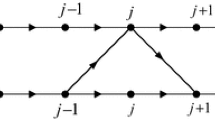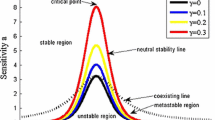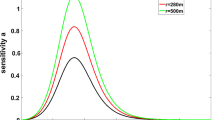Abstract
Considering topography conditions, economic factors and driving safety, in real traffic, a road may be built as curved road. Traffic flow on curved road is different from the one on straight road. And it is worth to investigate the influencing mechanism of traffic flow on curved road. In order to investigate traffic flow on curved road analytically, in this paper, an extended one-dimensional lattice hydrodynamic model for traffic flow on curved road is proposed. The stability condition is obtained by the use of linear stability analysis. It is shown that the stability of traffic flow varies with the radian, friction coefficient and curvature radius of curved road. The Burgers, Korteweg–de Vries and modified Korteweg–de Vries equations are derived to describe the nonlinear density waves in the stable, metastable and unstable regions, respectively. The simulations are given to verify the analytical results. The results, which obtained from the theoretical analysis and numerical simulations, show that traffic flow may be affected by the angle going into curved road, the increment of angle, friction coefficient and curvature radius of curved road. And the maximal theoretical flux and velocity of traffic flow are influenced by the above factors as well.






























Similar content being viewed by others
References
Helbing, D.: Traffic and related self-driven many-particle systems. Rev. Mod. Phys. 73(4), 1067–1141 (2001)
Nagatani, T.: The physics of traffic jams. Rep. Prog. Phys. 65, 1331–1386 (2002)
Schadschneider, A.: Traffic flow: a statistical physics point of view. Phys. A 313, 1–40 (2002)
Chowdhury, D., Santen, L., Schadschneider, A.: Statistical physics of vehicular traffic and some related systems. Phys. Rep. 329, 199–368 (2000)
Schadschneider, A., Chowdhury, D., Nishinari, K.: Stochastic Transport in Complex Systems—From Molecules to Vehicles. Elsevier, Amsterdam (2010)
Jiang, R., Wu, Q.S., Zhu, Z.J.: Full velocity difference model for a car-following theory. Phys. Rev. E 64(1), 017101 (2001)
Xue, Y., Dong, L.Y., Yuan, Y.W., Dai, S.Q.: The effect of the relative velocity on traffic flow. Commun. Theor. Phys. 38(2), 230–234 (2002)
Peng, G.H., Cai, X.H., Liu, C.Q., Cao, B.F., Tuo, M.X.: Optimal velocity difference model for a car-following theory. Phys. Lett. A 375(45), 3973–3977 (2011)
Yu, L., Li, T., Shi, Z.K.: Density waves in a traffic flow with reaction-time delay. Phys. A 389, 2607–2616 (2010)
Ge, H.X., Cheng, R.J., Dai, S.Q.: KdV and kink–antikink solitons in car-following models. Phys. A 357, 466–476 (2005)
Tang, T.Q., Wang, Y.P., Yang, X.B., Wu, Y.H.: A new car-following model accounting for varying road condition. Nonlinear Dyn. 70(2), 1397–1405 (2012)
Zhou, J., Shi, Z.K., Cao, J.L.: Nonlinear analysis of the optimal velocity difference model with reaction-time delay. Phys. A 396, 77–87 (2014)
Zhou, J., Shi, Z.K., Cao, J.L.: An extended traffic flow model on a gradient highway with the consideration of the relative velocity. Nonlinear Dyn. 78, 1765–1779 (2014)
Lee, H.K., Lee, H.W., Kim, D.: Steady-state solutions of hydrodynamic traffic models. Phys. Rev. E 69(1), 016118 (2004)
Kerner, B.S., Klenov, S.L., Hiller, A.: Empirical test of a microscopic three-phase traffic theory. Nonlinear Dyn. 49(4), 525–553 (2007)
Nagatani, T., Nakanishi, K.: Delay effect on phase transitions in traffic dynamics. Phys. Rev. E 57(6), 6415–6421 (1998)
Kerner, B.S., Konhauser, P.: Cluster effect in initially homogeneous traffic flow. Phys. Rev. E 48(4), 2335–2338 (1993)
Kurtze, D.A., Hong, D.C.: Traffic jams, granular flow, and soliton selection. Phys. Rev. E 52(1), 218–221 (1995)
Zhu, W.X., Zhang, L.D.: Friction coefficient and radius of curvature effects upon traffic flow on a curved road. Phys. A 391, 4597–4605 (2012)
Nagatani, T.: Modified KdV equation for jamming transition in the continuum models of traffic. Phys. A 271, 599–607 (1998)
Nagatani, T.: Jamming transition in traffic flow on triangular lattice. Phys. A 271, 200–221 (1999)
Nagatani, T.: Jamming transition in a two-dimensional traffic flow model. Phys. Rev. E 59, 4857–4864 (1999)
Nagatani, T.: Jamming transition of high-dimensional traffic dynamics. Phys. A 272, 592–611 (1999)
Peng, G.H.: A new lattice model of the traffic flow with the consideration of the driver anticipation effect in a two-lane system. Nonlinear Dyn. 73, 1035–1043 (2013)
Peng, G.H., Cai, X.H., Liu, C.Q., Tuo, M.X.: A new lattice model of traffic flow with the anticipation effect of potential lane changing. Phys. Lett. A 376, 447–451 (2012)
Peng, G.H., Cai, X.H., Liu, C.Q., Cao, B.F.: A new lattice model of traffic flow with the consideration of the driver’s forecast effects. Phys. Lett. A 375, 2153–2157 (2011)
Peng, G.H., Cai, X.H., Cao, B.F., Liu, C.Q.: A new lattice model of traffic flow with the consideration of the traffic interruption probability. Phys. A 391, 656–663 (2012)
Peng, G.H., He, H.D., Lu, W.Z.: A new lattice model with the consideration of the traffic interruption probability for two-lane traffic flow. Nonlinear Dyn. (2015). doi:10.1007/s11071-015-2001-9
Peng, G.H., Cai, X.H., Cao, B.F., Liu, C.Q.: Non-lane-based lattice hydrodynamic model of traffic flow considering the lateral effects of the lane width. Phys. Lett. A 375, 2823–2827 (2011)
Zhang, M., Sun, D.H., Tian, C.: An extended two-lane traffic flow lattice model with driver’s delay time. Nonlinear Dyn. 77, 839–847 (2014)
Gupta, A.K., Redhu, P.: Analyses of drivers anticipation effect in sensing relative flux in a new lattice model for two-lane traffic system. Phys. A 392, 5622–5632 (2013)
Gupta, A.K., Redhu, P.: Analyses of the drivers anticipation effect in a new lattice hydrodynamic traffic flow model with passing. Nonlinear Dyn. 76, 1001–1011 (2014)
Gupta, A.K., Sharma, S., Redhu, P.: Effect of multi-phase optimal velocity function on jamming transition in a lattice hydrodynamic model with passing. Nonlinear Dyn. (2015). doi:10.1007/s11071-015-1929-0
Zhang, G., Sun, D.H., Liu, W.N., Zhao, M., Chen, S.L.: Analysis of two-lane lattice hydrodynamic model with consideration of drivers’ characteristics. Phys. A 422, 16–24 (2015)
Zhang, G., Sun, D.H., Liu, W.N.: Analysis of a new two-lane lattice hydrodynamic model with consideration of the global average flux. Nonlinear Dyn. (2015). doi:10.1007/s11071-015-2095-0
Wang, T., Gao, Z.Y., Zhang, W.Y., Zhang, J., Li, S.B.: Phase transitions in the two-lane density difference lattice hydrodynamic model of traffic flow. Nonlinear Dyn. 77, 635–642 (2014)
Wang, T., Gao, Z.Y., Zhang, J.: Stabilization effect of multiple density difference in the lattice hydrodynamic model. Nonlinear Dyn. 73, 2197–2205 (2013)
Ge, H.X., Cheng, R.J.: The “backward looking” effect in the lattice hydrodynamic model. Phys. A 387, 6952–6958 (2008)
Zhu, W.X., Zhang, L.D.: A novel lattice traffic flow model and its solitary density waves. Int. J. Mod. Phys. C 23(3), 1250025 (2012)
Cao, J.L., Shi, Z.K.: A novel lattice traffic flow model on a curved road. Int. J. Mod. Phys. C (2015). doi:10.1142/S0129183115501211
Nagatani, T.: Thermodynamic theory for the jamming transition in traffic flow. Phys. Rev. E 58(4), 4271–4276 (1998)
Nayfeh, A.H.: Introduction to Perturbation Techniques. Wiley, New York (1981)
Acknowledgments
The authors wish to thank the anonymous referees for their useful comments. This work was partially supported by the National Natural Science Foundation of China (Grant No. 61134004), Zhejiang Province National Science Foundation (Grant No. LY12A010 09) and Scientific Research Fund of Zhejiang Provincial Education Department (Grant No. Y201328023).
Author information
Authors and Affiliations
Corresponding author
Rights and permissions
About this article
Cite this article
Zhou, J., Shi, ZK. Lattice hydrodynamic model for traffic flow on curved road. Nonlinear Dyn 83, 1217–1236 (2016). https://doi.org/10.1007/s11071-015-2398-1
Received:
Accepted:
Published:
Issue Date:
DOI: https://doi.org/10.1007/s11071-015-2398-1




